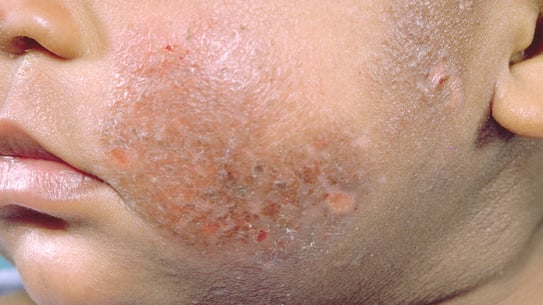1 professionals
Diaper Dermatitis: Clinic, diagnosis and treatment
Diaper Dermatitis: Clinic, diagnosis and treatment
URL copied
Medical review: Dr. Marina Alexandre, Dermatologist, Avicenne Hospital, France.
Related topics
Treating diaper dermatitis starts with preventative measures, such as:
The increasingly more elaborate diapers are factors of acute contact eczema, with the appearance of erythematous vesicular placard. It is most commonly seen on:
Fig: Seborrheic dermatitis in infants

Fig: Acrodermatitis Enteropathica

In the case of a dermatosis, these treatments are associated with a specific therapy:
Local antibiotic therapy adapted to the germ responsible: fusidic acid cream for staphylococcus and mupirocin for streptococcus and staphylococcus, often combined with general antibiotic therapy for 10 days: penicillin or macrolides (erythromycin)2,4.
Topical imidazoles in the form of cream or milk for 15 days, with possible use of brief topical corticosteroid therapy (10 to 15 days), using a non-fluorinated level 2 corticosteroid if imidazoles fail3.
Brief (10-15 days) local corticosteroid therapy using a low or medium potency non-fluorinated corticosteroid to control the flare1.
Regular zinc supplementation: zinc gluconate6.
Prompt referral to a specialized facility7.
What about products traditionally used locally such as trolamine, fish liver oil + zinc oxide, dexpanthenol?
Is there a place for dyes such as eosin?
What cosmetics can be used to act as a "barrier" to natural excretions: to use both on healthy skin as a preventative measure and on a non-infected diaper rash?
Can talcum powder help?
We hear that you should stop using liniment once the diaper dermatitis has set in because it worsens the process instead of improving it. Is this true?
What is meant by "persistent dermatitis"? How long does it last?
A persistent dermatitis is a dermatitis that lasts several days with a tendency to worsen despite local treatment.
Create easily your professional account
I create my accountAccess exclusive business services unlimited
Access valuable features : audio listening & tools sharing with your patients
Access more than 150 product sheets, dedicated to professionals
